RCMP
Drugs, gun, money seized as RCMP arrest 2 in Red Deer
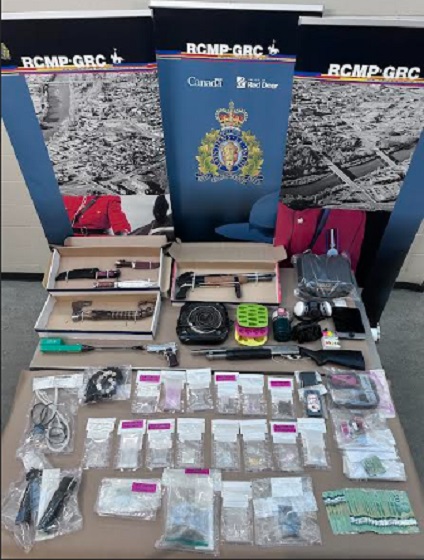
News release from Red Deer RCMP
Red Deer RCMP General Investigation Section arrest two for drug and weapon offences
On Oct. 30, 2024, Red Deer RCMP General Investigation Section (GIS) with the assistance of the Red Deer RCMP Crime Reduction Team arrested two individuals as a result of a drug trafficking investigation. Police executed search warrants at a motel room and a motor vehicle in North Red Deer. As a result of the investigation, police seized several items and controlled substances, which included: fentanyl, methamphetamine, cocaine, Canadian currency, two firearms, other weapons and items related to the trafficking of controlled substances.
Destiny Green, a 26-year-old resident of Red Deer, and Tyler Bye, a 31-year-old resident of Red Deer, have been charged with the following:
- Possession of a controlled substance for the purpose of trafficking
- Possess items used to traffic in controlled substances
- Unauthorized possession of a firearm
- Possession of a firearm knowing possession is unauthorized
- Possession of a firearm in a motor vehicle
- Possession of a weapon for a dangerous purpose x2
- Unsafe storage of a firearm
Green is also charged with:
- Fail to comply with firearms prohibition
Both Destiny Green and Taylor Bye were taken before a Justice of the Peace and were remanded into custody. They are scheduled appear in court on Nov. 7, 2024, at the Alberta Court of Justice in Red Deer.
“The harm caused by fentanyl trafficking shows itself in many different ways” says Cst. Andrew Devine of Red Deer RCMP GIS. “Any time police remove these dangerous substances from our neighbourhoods, we are making our community safer.”
Brownstone Institute
RCMP seem more interested in House of Commons Pages than MP’s suspected of colluding with China
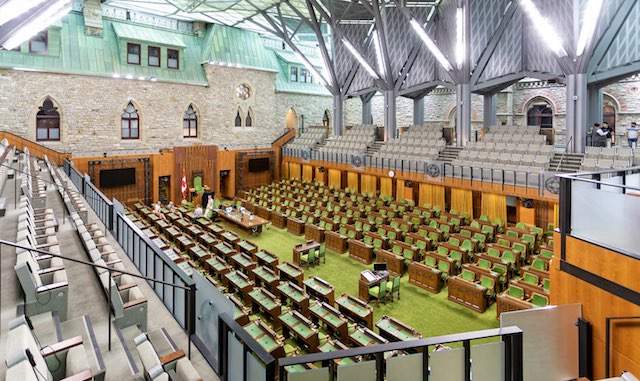
From the Brownstone Institute
By
Canadians shouldn’t have information about their wayward MPs, but the RCMP can’t have too much biometric information about regular people. It’s always a good time for a little fishing. Let’s run those prints, shall we?
Forget the members of Parliament who may have colluded with foreign governments. The real menace, the RCMP seem to think, are House of Commons pages. MPs suspected of foreign election interference should not be identified, the Mounties have insisted, but House of Commons staff must be fingerprinted. Serious threats to the country are hidden away, while innocent people are subjected to state surveillance. If you want to see how the managerial state (dys)functions, Canada is the place to be.
In June, the National Security and Intelligence Committee of Parliamentarians (NSICOP) tabled its redacted report that suggested at least 11 sitting MPs may have benefitted from foreign election interference. RCMP Commissioner Mike Duheme cautioned against releasing their identities. Canadians remained in the dark until Oct. 28 when Kevin Vuong, a former Liberal MP now sitting as an Independent, hosted a news conference to suggest who some of the parliamentarians may be. Like the RCMP, most of the country’s media didn’t seem interested.
But the RCMP are very interested in certain other things. For years, they have pushed for the federal civil service to be fingerprinted. Not just high security clearance for top-secret stuff, but across government departments. The Treasury Board adopted the standard in 2014 and the House of Commons currently requires fingerprinting for staff hired since 2017. The Senate implemented fingerprinting this year. The RCMP have claimed that the old policy of doing criminal background checks by name is obsolete and too expensive.
But stated rationales are rarely the real ones. Name-based background checks are not obsolete or expensive. Numerous police departments continue to use them. They do so, in part, because name checks do not compromise biometric privacy. Fingerprints are a form of biometric data, as unique as your DNA. Under the federal Identification of Criminals Act, you must be in custody and charged with a serious offence before law enforcement can take your prints. Canadians shouldn’t have information about their wayward MPs, but the RCMP can’t have too much biometric information about regular people. It’s always a good time for a little fishing. Let’s run those prints, shall we?
It’s designed to seem like a small deal. If House of Commons staff must give their fingerprints, that’s just a requirement of the job. Managerial bureaucracies prefer not to coerce directly but to create requirements that are “choices.” Fingerprints aren’t mandatory. You can choose to provide them or choose not to work on the Hill.
Sound familiar? That’s the way Covid vaccine mandates worked too. Vaccines were never mandatory. There were no fines or prison terms. But the alternative was to lose your job, social life, or ability to visit a dying parent. When the state controls everything, it doesn’t always need to dictate. Instead, it provides unpalatable choices and raises the stakes so that people choose correctly.
Government intrudes incrementally. Digital ID, for instance, will be offered as a convenient choice. You can, if you wish, carry your papers in the form of a QR code on your phone. Voluntary, of course. But later there will be extra hoops to jump through to apply for a driver’s licence or health card in the old form.
Eventually, analogue ID will cost more, because, after all, digital ID is more automated and cheaper to run. Some outlets will not recognize plastic identification. Eventually, the government will offer only digital ID. The old way will be discarded as antiquated and too expensive to maintain. The new regime will provide the capacity to keep tabs on people like never before. Privacy will be compromised without debate. The bureaucracy will change the landscape in the guise of practicality, convenience, and cost.
Each new round of procedures and requirements is only slightly more invasive than the last. But turn around and find you have travelled a long way from where you began. Eventually, people will need digital ID, fingerprints, DNA, vaccine records, and social credit scores to be employed. It’s not coercive, just required for the job.
Occasionally the curtain is pulled back. The federal government unleashed the Emergencies Act on the truckers and their supporters in February 2022. Jackboots in riot gear took down peaceful protesters for objecting to government policy. Authorities revealed their contempt for law-abiding but argumentative citizens. For an honest moment, the government was not incremental and insidious, but enraged and direct. When they come after you in the streets with batons, at least you can see what’s happening.
We still don’t know who colluded with China. But we can be confident that House of Commons staffers aren’t wanted for murder. The RCMP has fingerprints to prove it. Controlling the people and shielding the powerful are mandates of the modern managerial state.
Republished from the Epoch Times
espionage
Canada’s Missing Intelligence Command: Convoy Review Takes on New Relevance After FBI Warnings
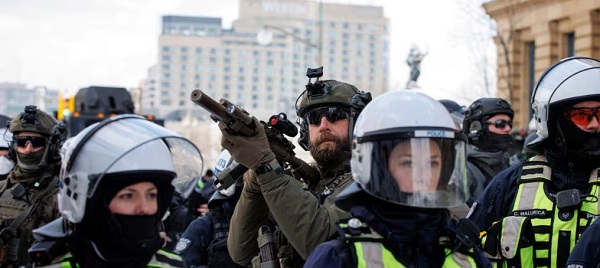
 Sam Cooper
Sam Cooper
An element overlooked in previous analyses of Natterjack may be its most damning: the complete absence of an organizing vision across Canada’s security and intelligence arms.
As Ottawa faces mounting pressure from Washington to respond to fentanyl trafficking, human smuggling, and terror threats stemming from a convergence of Chinese Communist operatives and transnational mafias from Mexico and Iran, a fresh assessment of Canada’s policing strategy and governance reveals the stunning absence of a “Criminal Intelligence Committee to deal with a number of intelligence policy and related issues”—while simultaneously raising troubling doubts about the RCMP’s capacity to prioritize, analyze, and target serious threats free from political influence.
The Bureau’s comparative analysis is based on a sweeping 2024 external review of the RCMP’s response to the pandemic-era “freedom convoy,” which suggests Canada’s federal police force—working for “clients” who do not understand or value how intelligence should shape decision-making—bent under severe political pressure, compromising its intelligence collection and reporting integrity, and helping execute an unprecedented crackdown on citizens’ financial freedoms during the winter 2022 protests in Ottawa.
The 92-page report, produced under a post-operation initiative called Project Natterjack, paints a portrait of intelligence breakdowns, governance failure, and inappropriate political influence—particularly from senior officials in Prime Minister Justin Trudeau’s government. The review, first obtained by The Canadian Press under the Access to Information Act, included survey responses from 1,641 RCMP officers and personnel deployed during the protests, which paralyzed downtown Ottawa and disrupted key international border crossings.
Yet an element overlooked in previous analyses of Natterjack may be its most damning: the complete absence of an organizing vision across Canada’s security and intelligence arms.
This structural vacuum comes at a time when the national security threats facing Canada are increasingly hybridized—blending terrorism, organized crime, election interference, cyber warfare, and financial infiltration. These are precisely the kinds of threats Washington is now pressing Ottawa to address, including investigations into fentanyl superlabs and hostile networks tied to the Chinese Communist Party, Mexican cartels, and Iranian and Russian threat actors.
Amid what the U.S. government sees as a growing vulnerability that Ottawa has failed to address in coordination with Washington under Trudeau’s Liberals, the Natterjack report highlights a deeply relevant structural failure in Canadian policing.
“Many interviewees expressed a level of concern that beyond the informal networks that loosely bind criminal, tactical, and strategic analysts from a variety of law enforcement and security and intelligence agencies, there is not a recognized national body that comes together to advocate, address and advance issues in criminal analysis,” the report states. “The absence of a Criminal Intelligence Committee to deal with a number of intelligence policy and related issues appears glaringly missing and should be explored.”
Regarding the “freedom convoy,” the review’s most serious suggestion is that RCMP intelligence officers felt pressured to present the protests through the lens of “ideologically motivated violent extremism”—a national security framework typically reserved for terrorism investigations. Intelligence teams were subjected to hourly briefing demands from federal officials and were forced to issue rapid assessments under tight timelines, with resulting reports often presenting skewed or misattributed findings.
“Interviewees also indicated that there were issues with information and intelligence that was disseminated to external Government of Canada agencies,” the report states. “Specifically, some Government of Canada partners would misrepresent the information or misattribute third-party information as RCMP information… Interviewees and survey respondents felt immense pressure from the Government of Canada to be briefed on a regular basis… in particular when briefings were requested on an hourly basis.”
As the review notes bluntly: “When there is that much pressure to produce a report within an hour or a few hours’ time, it is not productive.”
Taken together, the findings paint a sobering portrait of a federal police force struggling to preserve its independence and credibility under political strain. While officers were deployed to confront a disruptive but largely peaceful protest, critics inside and outside government have pointed to the RCMP’s relative inaction toward far more dangerous networks—namely, fentanyl trafficking cartels, Chinese underground banking structures linked to the same political influence operations involved in federal election interference, intelligence-connected money laundering syndicates, and hostile state-sponsored actors operating inside Canada.
One telling passage indicating a scramble within RCMP command to produce findings on ideological extremism—whether fully valid or not—reads: “Ideologically Motivated Criminal Intelligence Team and the Joint Intelligence Group were both operating to provide the strategic threat picture, and reaching in directly to the Divisions for intelligence updates. As such, some interviewees noted that they were inundated by requests for intelligence updates from different intelligence teams at National Headquarters.”
In parallel, the federal cabinet invoked the Emergencies Act—suspending civil liberties and activating sweeping enforcement powers that allowed financial institutions to freeze protestors’ bank accounts. Between February 15 and 23, 2022, the RCMP’s Federal Policing Criminal Operations Financial Crimes Unit made 57 disclosures to banks and other institutions, targeting 62 individuals and 17 businesses for asset freezes.
The report pointedly states: “The act of participating in a demonstration is not in itself a form of ideologically motivated violent extremism.” Yet that nuance appeared largely lost amid the political urgency to classify the protests as a national threat.
Interviewees also noted limitations in their ability to disseminate protected information and intelligence to certain external agencies and private financial institutions. Specifically, they indicated that encryption was not consistently available across these external channels.
Perhaps most revealingly, the review found that senior officials—referred to as intelligence “clients”—did not appear to value intelligence or allow it to meaningfully guide decision-making during the crisis. “Interviewees and survey respondents expressed the need to educate intelligence clients on the value of intelligence and how it can be used for decision making,” the report notes. “Interviewees noted that the role of intelligence was not valued during the convoy-related events.” The admission sits uneasily beside the broader findings: that RCMP intelligence was not only shaped to support a political narrative that exaggerated the role of ideological extremism in the protests, but ultimately sidelined when it failed to serve that narrative.
The report also paints a picture that fits with a serious assertion previously conveyed to The Bureau by an RCMP source: that in the days following the convoy’s dispersal, investigators felt they were pressured to reconstruct investigative timelines to match political expectations—to sustain a national security narrative even when the underlying evidence did not necessarily meet threshold.
The Emergencies Act was revoked after just nine days. In January 2024, a federal judge ruled that the Trudeau government’s invocation of the Act was both unnecessary and unlawful, concluding that the legal threshold for a national emergency had not been met.
According to the review, RCMP officials shared protected personal information with financial institutions using processes that lacked consistent legal oversight. The Office of the Privacy Commissioner raised formal concerns, citing the RCMP’s reliance on open-source and social media research to flag individuals—many of whom had no demonstrated connection to criminal activity.
The Natterjack review further confirms that RCMP intelligence operations during the protests were defined by duplication, confusion, and political interference. At least three separate intelligence units—the Ideologically Motivated Criminal Intelligence Team, the Combined Intelligence Group, and the Joint Intelligence Group—were simultaneously tasked with protest reporting, resulting in overlapping and sometimes circular intelligence products. RCMP sources said the structure was unsustainable and exacerbated by National Headquarters’ failure to provide unified command or governance.
Meanwhile, on Sunday, in a televised interview that sent shockwaves through Washington, Ottawa, and Victoria, FBI Director Kash Patel warned that a new axis of global threat actors—consisting of Chinese Communist Party operatives, Iranian proxies, and Mexican cartel networks—is exploiting Canada’s lax border enforcement, immigration systems, and critical infrastructure in Vancouver to move fentanyl and terror suspects into the United States.
“Where’s all the fentanyl coming from still? Where are all the narco traffickers going to keep bringing this stuff into the country? The northern border,” Patel said. “Our adversaries have partnered up with the CCP and others—Russia, Iran—on a variety of different criminal enterprises. And they’re going and they’re sailing around to Vancouver and coming in by air.”
Patel’s public assessment aligns disturbingly well with the key findings of a Bureau investigation first published in August 2024. That report, based on testimony and documentary evidence from former Canada Border Services Agency officer Luc Sabourin, warned that systemic corruption and compromised enforcement at Canada’s ports of entry had already created the kind of vulnerabilities now cited by the FBI.
The Bureau is a reader-supported publication.
To receive new posts and support my work, consider becoming a free or paid subscriber.
Invite your friends and earn rewards
-

 Addictions23 hours ago
Addictions23 hours agoMan jailed for trafficking diverted safer supply drugs, sparking fresh debate over B.C. drug policies
-

 Alberta1 day ago
Alberta1 day agoHow Trump and Alberta might just save Canada
-
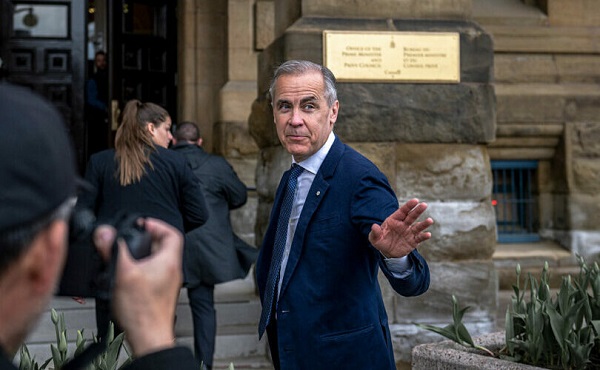
 Business24 hours ago
Business24 hours agoThe Liberals Finally Show Up to Work in 2025
-

 Alberta23 hours ago
Alberta23 hours agoJann Arden’s Rant Will Only Fuel Alberta’s Separation Fire
-

 Bruce Dowbiggin20 hours ago
Bruce Dowbiggin20 hours agoCaitlin Clark Has Been The Real Deal. So Her WNBA Rivals Hate Her
-
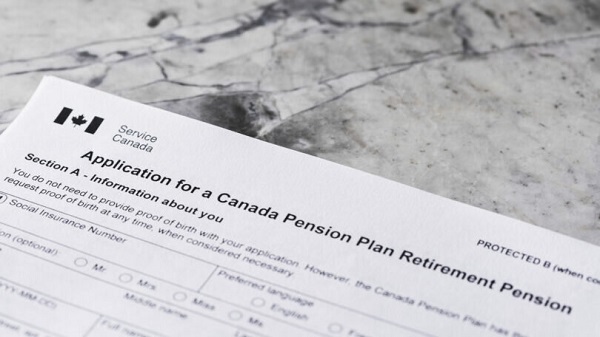
 Banks21 hours ago
Banks21 hours agoCanada Pension Plan becomes latest institution to drop carbon ‘net zero’ target
-

 Daily Caller22 hours ago
Daily Caller22 hours agoThere’s A Catch To California’s Rosy Population Stats
-

 espionage2 days ago
espionage2 days agoTrudeau Government Unlawfully Halted CSIS Foreign Operation, Endangering Officers and Damaging Canada’s Standing With Allies, Review Finds




